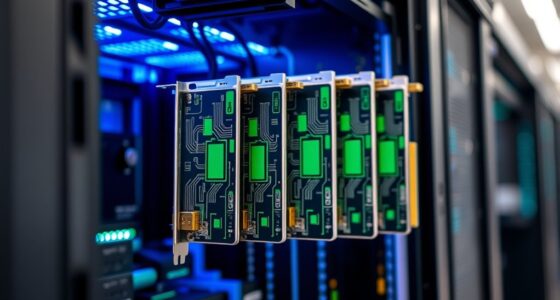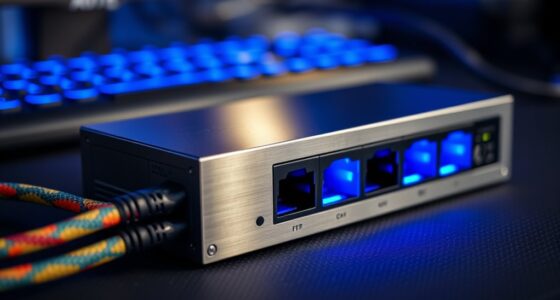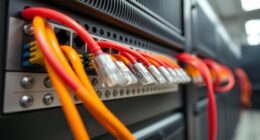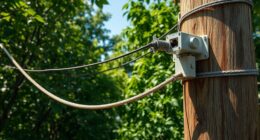If you’re looking for the best temperature and humidity sensors for racks, I recommend considering options like Bluetooth data loggers, cellular monitors with app alerts, and rackmount sensors like the APC AP9335TH. I also suggest compact hygrometers, digital meters, and WiFi-enabled devices that provide real-time data and easy setup. These tools guarantee ideal conditions for your equipment. Keep exploring, and you’ll discover more about the top choices that fit your needs perfectly.
Key Takeaways
- Compatibility with rack environments, including mounting options and precise measurement capabilities.
- High accuracy and reliable alerts for maintaining optimal temperature and humidity conditions.
- Wireless or wired connectivity for real-time monitoring across multiple rack locations.
- User-friendly interface with clear displays, data logging, and trend analysis features.
- Long-term data storage and alert customization to prevent environmental fluctuations.
Wireless Temperature and Humidity Sensor with Bluetooth Data Logger
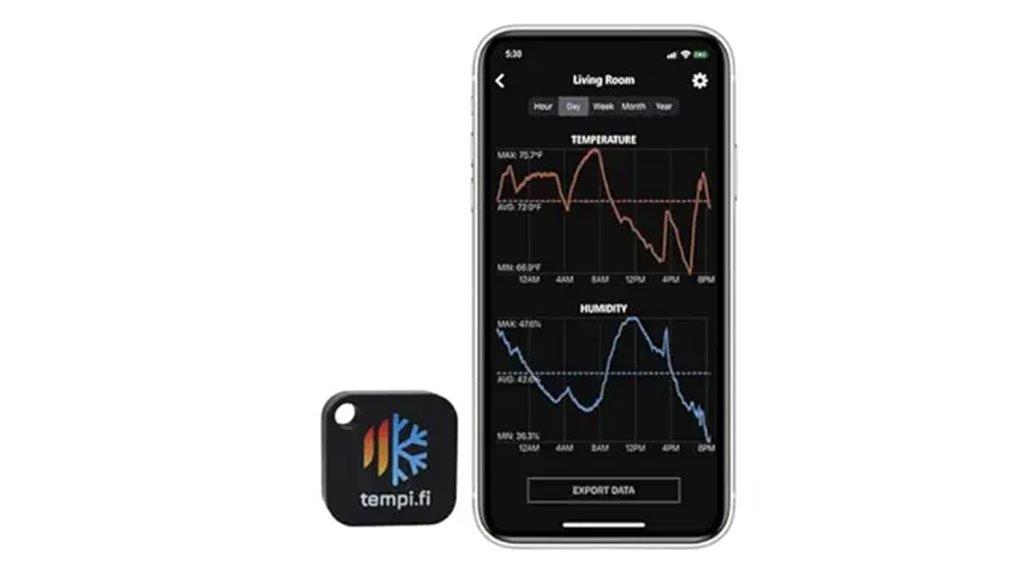
If you’re looking for a reliable way to monitor temperature and humidity in racks or other confined spaces, the Wireless Temperature and Humidity Sensor with Bluetooth Data Logger is an excellent choice. Developed in the USA, it works as a 24/7 data logger with alarm features, automatically recording data every minute and syncing it to your phone. Its Bluetooth-only connection offers a range of about 330 feet, making it suitable for large spaces. You can monitor multiple sensors simultaneously, receive immediate alerts, and easily export historical data as CSV files. Its compact design allows discreet placement in freezers, refrigerators, or other environments, ensuring your conditions stay ideal.
Best For: those seeking a reliable, discreet Bluetooth temperature and humidity monitoring solution for large or confined spaces like freezers, greenhouses, or reptile cages.
Pros:
- Automatically records data every minute and syncs seamlessly with your phone for real-time monitoring.
- Supports multiple sensors simultaneously, allowing comprehensive environmental management.
- Offers unlimited data storage with easy export options as CSV files for detailed analysis.
Cons:
- Bluetooth-only connection limits range to approximately 330 feet, which may be restrictive in very large or obstructed areas.
- Does not include WiFi capability, so remote monitoring without a nearby Bluetooth connection is not possible.
- Requires a smartphone app for data access and alerts, which may not be ideal for users without smartphones.
Necto Cellular Temperature Monitor System with App Alerts
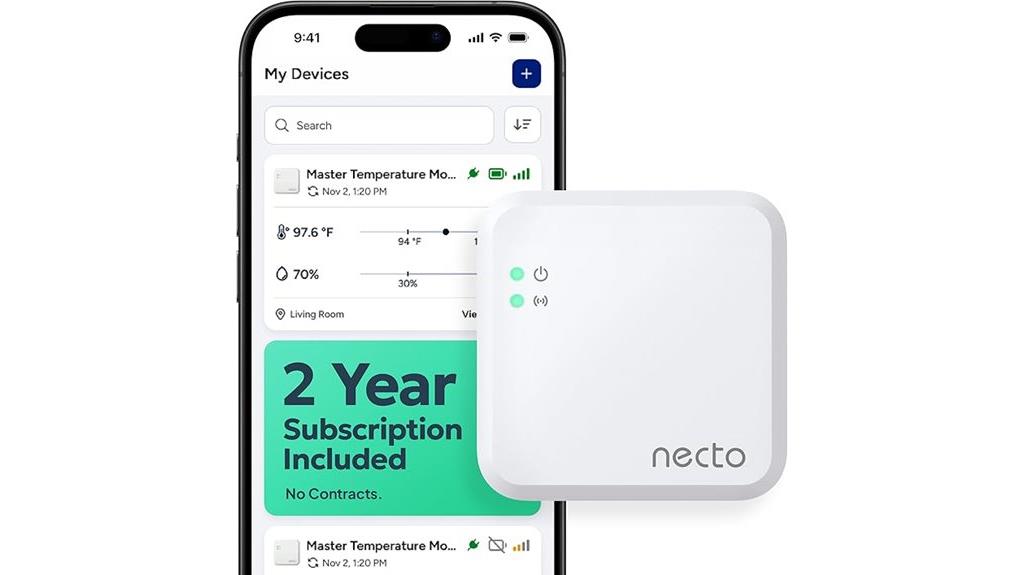
The Necto Cellular Temperature Monitor System with App Alerts is ideal for anyone who needs reliable, real-time environmental monitoring without relying on WiFi or contracts. It uses cellular connectivity with a built-in multi-network SIM, offering 2 years of included 4G LTE service—no hidden fees or long-term commitments. The device tracks temperature, humidity, and power outages, sending instant alerts via customizable text and email notifications. Easy to install and manage through a user-friendly app, it provides continuous updates every 10 seconds, ensuring your racks stay within ideal conditions. Plus, its rechargeable battery keeps monitoring active during power outages, giving you peace of mind always.
Best For: those needing reliable, real-time environmental monitoring in remote locations without WiFi or contracts, such as homeowners, RV owners, or businesses managing sensitive inventory.
Pros:
- No WiFi or internet required, relies solely on cellular connectivity with included 4G LTE service.
- Customizable alerts for temperature, humidity, and power outages sent instantly via text and email.
- Easy to install and operate through a user-friendly mobile app, with secure data storage for a year.
Cons:
- Rechargeable battery lasts approximately 3 days, requiring charging or replacement for continuous use.
- Limited to monitoring temperature, humidity, and power outages; does not support other environmental parameters.
- Requires cellular coverage; performance may vary in areas with poor signal strength.
APC Rackmount Temperature & Humidity Sensor, AP9335TH

Designed for data centers and network closets, the APC AP9335TH rackmount sensor excels at providing reliable temperature monitoring, especially for those who need a straightforward, plug-and-play solution. This compact device measures 9.1W x 2H inches and mounts easily on a tabletop, requiring no batteries. Operating on 240 volts, it monitors temperature up to approximately 30°C and tracks humidity levels between 10-90%. Users appreciate its simple setup, accurate temperature readings, and dependable alerts for over-temperature conditions. Despite some controversy over humidity measurement claims, the sensor remains a popular choice for proactive environment management, backed by positive customer feedback and reliable performance.
Best For: organizations seeking a reliable, easy-to-install temperature monitoring solution for data centers and network closets without the need for humidity measurement.
Pros:
- Simple plug-and-play setup with no batteries required
- Accurate temperature readings and dependable over-temperature alerts
- Compact design that mounts easily on a tabletop
Cons:
- Some users report it only measures temperature, despite marketing claims of humidity monitoring
- Higher price point compared to standalone temperature sensors with similar features
- Limited humidity measurement capabilities, which may not meet all environmental monitoring needs
ThermoPro TP50 Digital Hygrometer and Thermometer
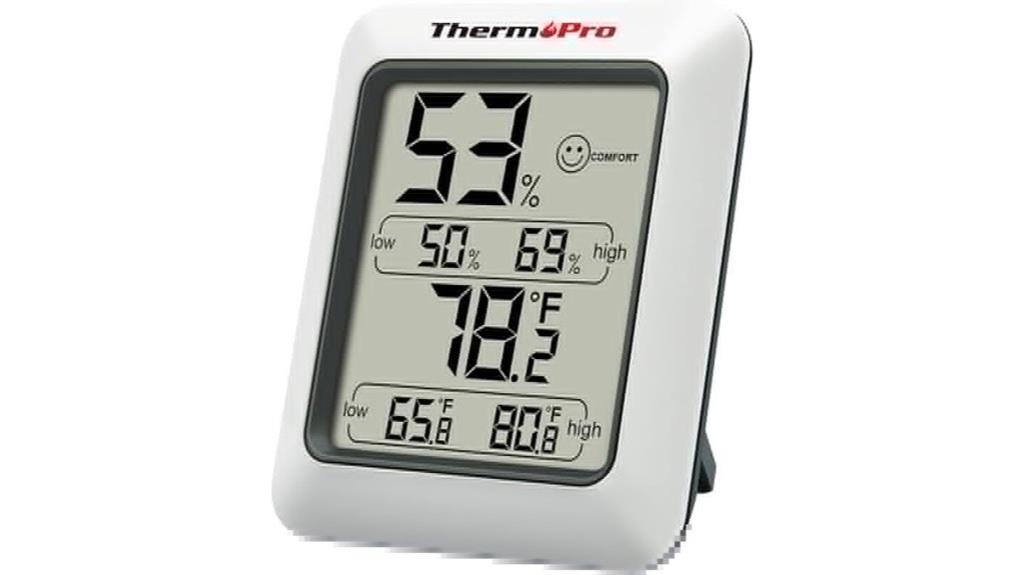
For anyone who needs quick, accurate readings of indoor temperature and humidity, the ThermoPro TP50 Digital Hygrometer and Thermometer stands out as a reliable choice. Its compact design includes a tabletop stand and magnetic back, making placement flexible on counters or refrigerators. With a ±2 to 3%RH humidity accuracy and ±1°F temperature precision, it delivers real-time data every 10 seconds. The device features an air comfort indicator with icons—DRY, COMFORT, WET—so I can quickly assess conditions. It also records high and low measurements, helping me monitor changes over time. This hygrometer is perfect for maintaining ideal environments for health, storage, or sensitive equipment.
Best For: individuals seeking quick, accurate indoor temperature and humidity readings for maintaining optimal health, comfort, or specialized environments.
Pros:
- Compact design with versatile placement options including tabletop stand and magnetic back
- High accuracy of ±2 to 3%RH for humidity and ±1°F for temperature, with real-time updates every 10 seconds
- Features an air comfort indicator with icons (DRY, COMFORT, WET) and records high/low environmental data
Cons:
- Requires AAA battery replacement when depleted
- Limited to indoor use; not suitable for outdoor conditions
- May need calibration over time to maintain maximum accuracy
PT6508 Temperature Humidity Meter with LCD Backlight

If you need a reliable way to monitor temperature and humidity within racks or confined spaces, the PT6508 Temperature Humidity Meter with LCD Backlight is an excellent choice. It combines humidity, temperature, dew point, and wet bulb measurements in one compact device, with dual displays for quick readings. The high-accuracy Sensirion SHT35 sensor ensures rapid stabilization, usually within 30 seconds. Its backlit LCD makes it easy to read in dark environments, and features like data storage, maximum/minimum recording, and auto-shutdown enhance usability. Perfect for HVAC, data centers, or sensitive environments, this meter offers precise, real-time environmental data for ideal condition management.
Best For: DIY enthusiasts, homeowners, and professionals needing quick, accurate indoor and outdoor humidity and temperature monitoring in confined or sensitive environments.
Pros:
- Rapid stabilization within approximately 30 seconds for real-time readings
- High accuracy with Sensirion SHT35 sensor and multifunctionality (humidity, temperature, dew point, wet bulb)
- Easy-to-read backlit LCD display suitable for dark environments
Cons:
- Requires holding the probe steady for 8-10 minutes to stabilize readings in certain areas
- Defaults to Celsius mode; manual adjustment needed to switch to Fahrenheit (does not remember preference)
- Designed primarily for home and hobbyist use; professional calibration may be necessary for industrial applications
GoveeLife 2.0 WiFi Hygrometer Thermometer (3 Pack)
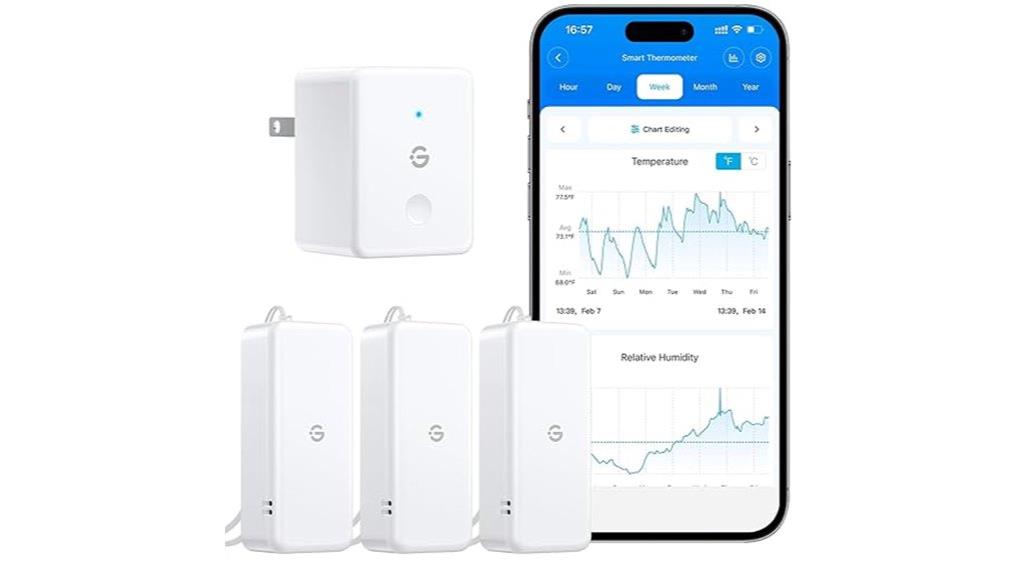
The GoveeLife 2.0 WiFi Hygrometer Thermometer (3 Pack) is an excellent choice for anyone needing precise, real-time monitoring of environmental conditions in sensitive storage areas. Its smart WiFi connectivity allows remote access via app, supporting up to 10 sensors with a WiFi gateway on 2.4GHz networks. The Swiss-made sensors provide highly accurate readings—±0.54°F / ±0.3℃ for temperature and ±3% RH for humidity—updating every 2 seconds. You can set alerts for threshold breaches, receiving notifications by app or email. The device also tracks trends over 20 days and exports data for up to 2 years, making it ideal for long-term environmental management.
Best For: individuals who need precise, remote monitoring of temperature and humidity in sensitive storage environments like wine cellars, greenhouses, or music instrument cases.
Pros:
- Supports remote monitoring and alerts via app and email for quick responses.
- High-precision Swiss-made sensors with fast 2-second data updates.
- Long-lasting battery life of up to 2 years and data export capabilities for extensive environmental analysis.
Cons:
- Requires a WiFi gateway (H5151/H5042) for pairing multiple sensors, adding extra setup complexity.
- Compatible only with 2.4GHz WiFi networks, limiting connectivity options in some environments.
- The compact design, while portable, may be less suitable for environments requiring more rugged or fixed installations.
Temperature Humidity Meter with Dual LCD Display and Backlight
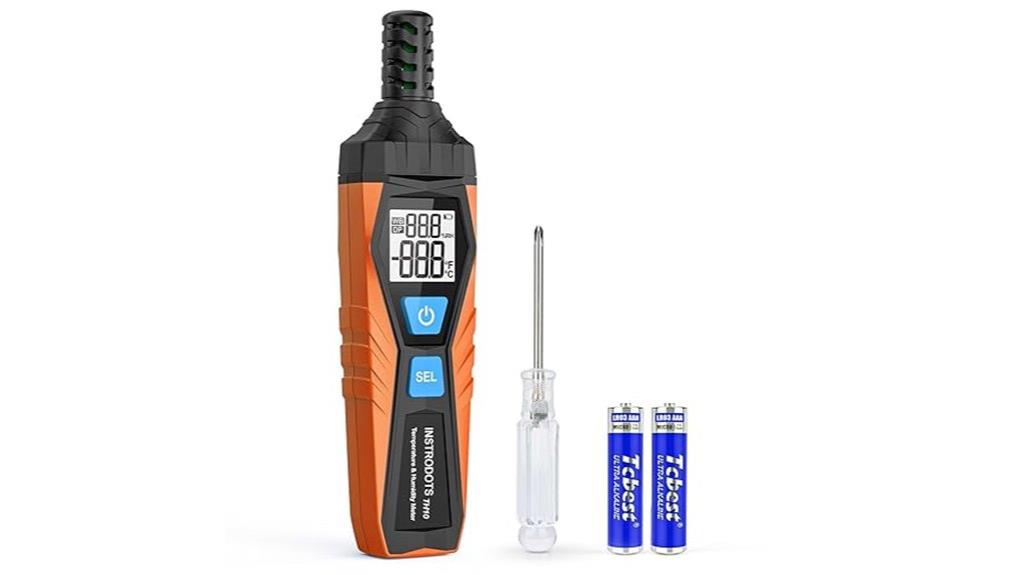
A Temperature Humidity Meter with Dual LCD Display and Backlight stands out as an ideal tool for anyone who needs quick, accurate environmental readings in low-light or challenging conditions. The INSTRODOTS TH10 is compact, portable, and features a dual LCD screen that displays temperature, humidity, dew point, and wet bulb temperature simultaneously. Its backlight ensures easy reading in dim environments, while the ergonomic ABS case provides durability and comfort. With high-precision Swiss sensors, it offers reliable measurements across a wide range of environments, from indoor racks to outdoor setups. Simple mode switching and unit conversion make it user-friendly, making this device a versatile choice for environmental monitoring.
Best For: professionals and enthusiasts needing quick, accurate environmental measurements in various settings, especially in low-light or challenging conditions.
Pros:
- Dual LCD display with backlight enhances readability in dim environments
- High-precision Swiss sensors provide reliable and accurate measurements
- Compact, portable design with ergonomic case for comfortable handling and durability
Cons:
- Wet bulb temperature readings may sometimes show discrepancies
- Response time for humidity stabilization can take up to 60 seconds
- Limited to environmental measurements; not suitable for industrial or highly specialized applications
6 Pack Mini Hygrometer Indoor Humidity Meter
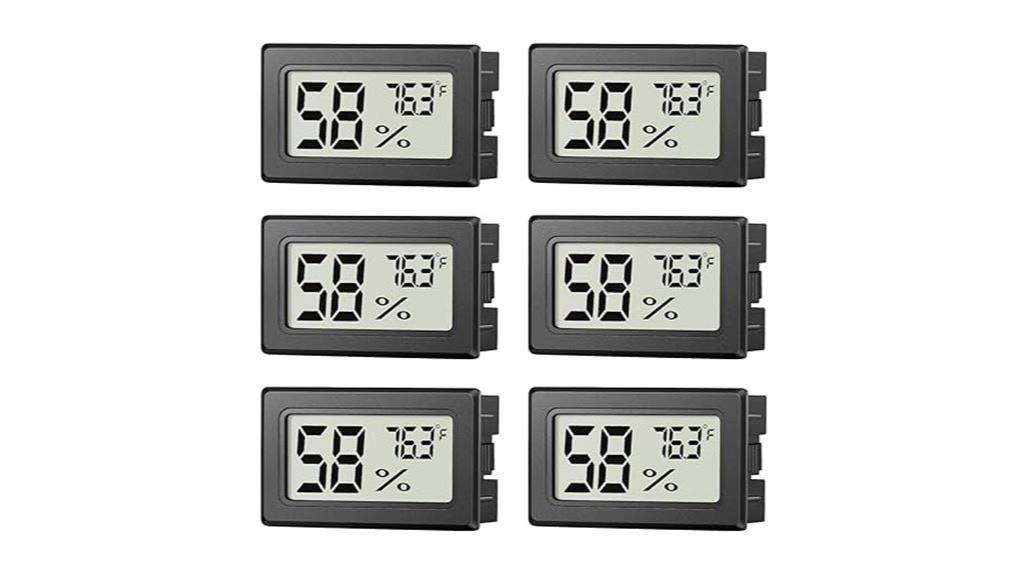
For anyone needing reliable, real-time humidity and temperature data in small spaces, the Pack Mini Hygrometer Indoor Humidity Meter is an excellent choice. I find its compact design perfect for monitoring environments like humidors, incubators, or guitar cases without cluttering the space. The device combines a high-precision thermometer and hygrometer, updating measurements every 10 seconds for accurate, current readings. Its clear digital display makes data easy to read, while the wide measurement range ensures versatility across different applications. Powered by long-lasting batteries, it offers hassle-free operation for up to 8 months, making it a dependable tool for maintaining ideal conditions in various environments.
Best For: those who need accurate, real-time humidity and temperature monitoring in small, confined spaces like humidors, incubators, and guitar cases.
Pros:
- Compact and stylish design easily fits in tight spaces without clutter
- Provides precise temperature (±2°F) and humidity (±5% RH) readings with automatic updates every 10 seconds
- Long-lasting battery life of up to 8 months with included LR44 batteries
Cons:
- Limited measurement range for temperature (-58°F to 158°F) may not suit extreme environments
- Requires replacement of button cell batteries after several months of use
- Digital display may be less visible in low-light conditions without additional lighting
ThermoPro TP49 Digital Hygrometer (3 Pieces)
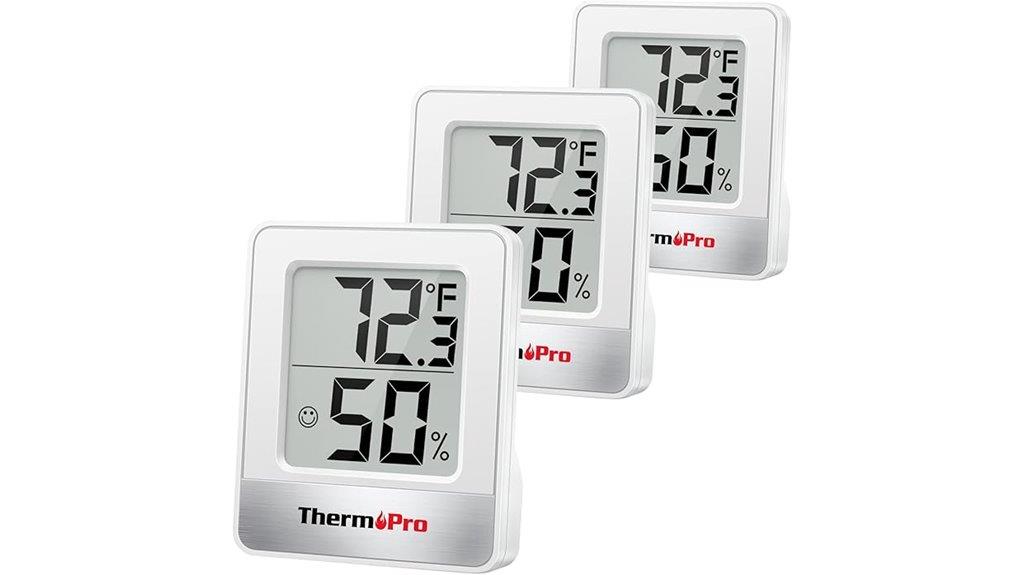
If you need a reliable way to monitor indoor and outdoor conditions, the ThermoPro TP49 Digital Hygrometer is an excellent choice, especially for those managing environments like greenhouses or server racks. It comes in a pack of three, offering flexibility and coverage for multiple areas. The device features a face icon comfort indicator that shows DRY, COMFORT, or WET air conditions, helping you quickly adjust humidifiers or dehumidifiers. Its high-precision sensors deliver accurate readings within ±1°F/°C and ±2-3% RH, with a large LCD display that updates every 10 seconds. Its versatile placement options include tabletop, magnetic, or wall-mounting, making it ideal for various environments.
Best For: DIY enthusiasts, greenhouse growers, and home environment managers seeking accurate, versatile humidity and temperature monitoring.
Pros:
- High-precision sensors deliver accurate readings within ±1°F/°C and ±2-3% RH.
- Multiple placement options including tabletop, magnetic, and wall-mount for versatile use.
- Face icon comfort indicator provides quick visual cues for indoor air quality adjustments.
Cons:
- Updates every 10 seconds may not be fast enough for real-time monitoring needs.
- Small LCD display might be less visible from a distance for some users.
- Requires batteries, which need periodic replacement to maintain functionality.
Indoor Outdoor Wireless Thermometer Hygrometer with Remote Sensor
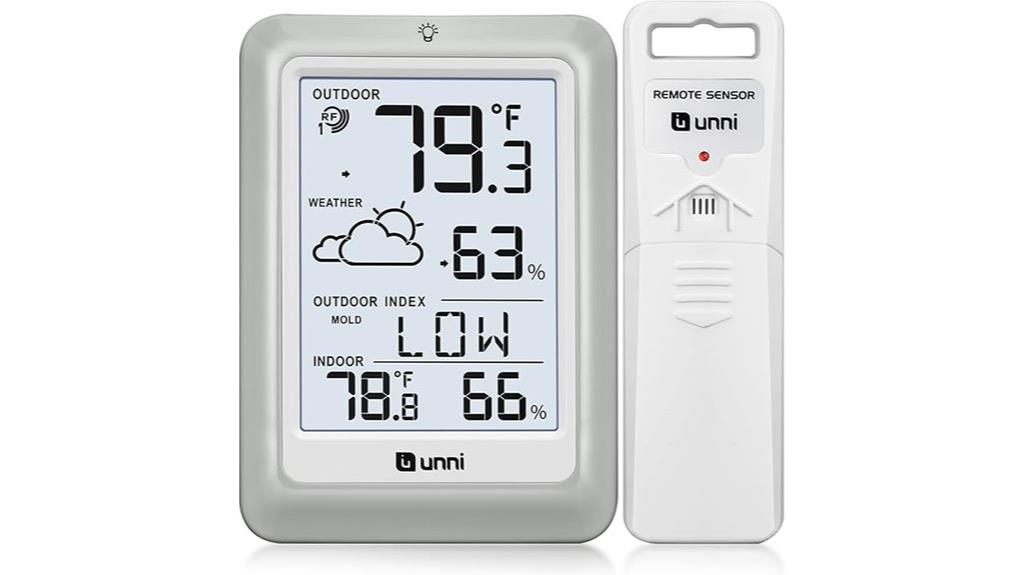
The Indoor Outdoor Wireless Thermometer Hygrometer with Remote Sensor is ideal for those who need accurate, real-time climate monitoring across multiple locations. It uses Swiss-made Sensirion sensors, providing temperature accuracy within ±0.5ºF and humidity within ±2%. With a wireless range of up to 330 feet, it supports up to three sensors, making it perfect for monitoring different areas simultaneously. The compact display is easy to read and can be wall-mounted or placed on a table, with a backlit button for visibility in darkness. It tracks indoor and outdoor conditions, including heat index and dew point, ensuring extensive environment management.
Best For: homeowners, gardeners, and environmental enthusiasts seeking precise, real-time indoor and outdoor climate monitoring across multiple locations.
Pros:
- Highly accurate Swiss-made Sensirion sensors with ±0.5ºF temperature and ±2% humidity precision
- Wireless range of up to 330 feet supports monitoring multiple areas simultaneously
- Compact, versatile display that can be wall-mounted or placed on a tabletop with backlit for easy reading in darkness
Cons:
- Batteries are not included, requiring additional purchase for setup
- Limited to supporting up to three sensors, which may not suffice for larger monitoring needs
- Data updates every 30 seconds, which might be slow for real-time critical applications
Indoor Outdoor Thermometer Wireless with 4.5 Inch Display
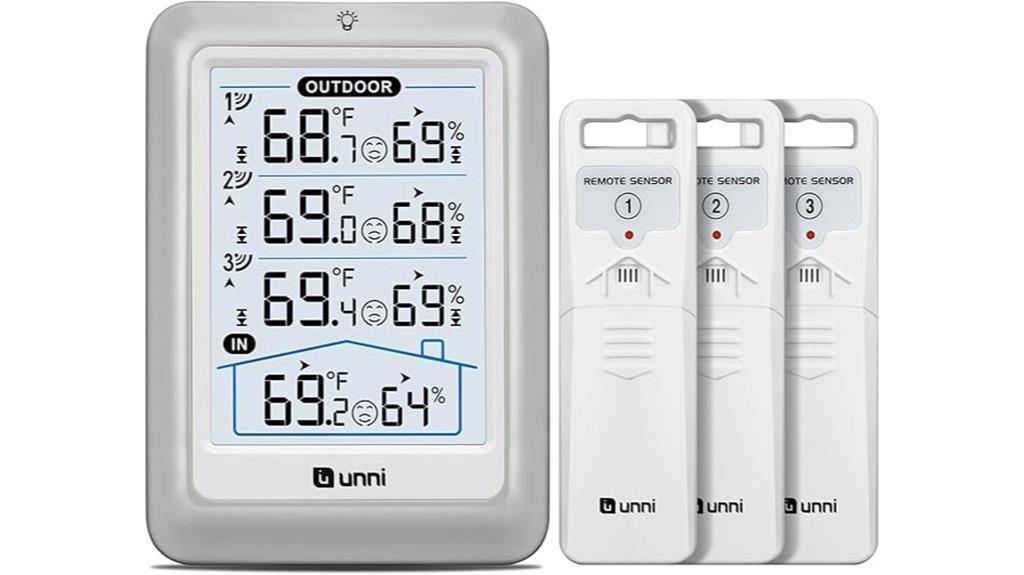
This wireless indoor-outdoor thermometer with a 4.5-inch display is ideal for anyone who needs quick, precise climate data across multiple locations. Its adjustable backlight and versatile mounting options make it easy to read and position. It includes three outdoor sensors, providing real-time indoor and outdoor temperature and humidity readings with trend indicators, MAX/MIN records, and alerts. With wireless transmission up to 330 feet, it reliably monitors multiple areas simultaneously. Powered via USB or batteries, it offers flexible operation. Its high accuracy, clear display, and extensive features make it an excellent choice for maintaining ideal conditions in racks or other environments.
Best For: individuals or professionals who need accurate, real-time climate monitoring across multiple indoor and outdoor locations with easy visibility and versatile mounting options.
Pros:
- Supports multiple outdoor sensors with wireless transmission up to 330 feet for comprehensive coverage
- Adjustable backlight and flexible mounting options for easy readability and placement
- High accuracy with real-time updates, trend indicators, MAX/MIN records, and alerts for optimal climate control
Cons:
- Requires batteries or USB power, which may necessitate replacements or charging
- Calibration and sensor placement are essential for maintaining accuracy over time
- Limited to a one-year warranty excluding batteries, so ongoing maintenance may be needed
ThermoPro WiFi Hygrometer and Thermometer with App Alerts
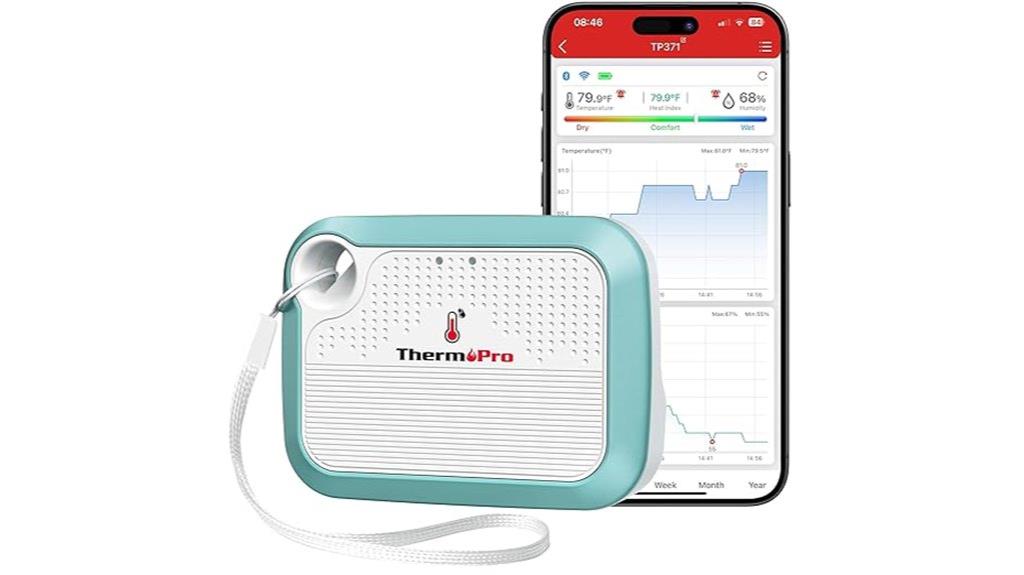
For anyone needing reliable, real-time monitoring of temperature and humidity, the ThermoPro WiFi Hygrometer and Thermometer with App Alerts is an excellent choice. It connects via stable Wi-Fi and Bluetooth, allowing easy access through the ThermoPro App on your phone. The device offers high accuracy with quick response times, measuring temperature within ±0.5°F and humidity within ±2%. It supports continuous data tracking, long-term storage, and trend analysis. Customizable alerts notify me immediately if conditions go beyond set thresholds. Its rechargeable battery ensures long-lasting performance, and setup is straightforward. Overall, it’s a dependable, user-friendly tool for maintaining ideal environmental conditions.
Best For: anyone seeking reliable, real-time monitoring of indoor environments such as homes, greenhouses, offices, or storage spaces with customizable alerts and long-term data tracking.
Pros:
- High accuracy with ±0.5°F temperature and ±2% humidity measurements.
- Supports 24/7 data tracking, long-term storage, and trend analysis via the app.
- Easy setup with stable Wi-Fi and Bluetooth connectivity and user-friendly app interface.
Cons:
- Only compatible with 2.4GHz Wi-Fi networks, limiting flexibility.
- Temperature updates may lag during rapid environmental changes, over 30 minutes in some cases.
- Occasional data gaps or delays in transmission, potentially due to hardware or network issues.
Factors to Consider When Choosing a Temperature and Humidity Sensor for Rack
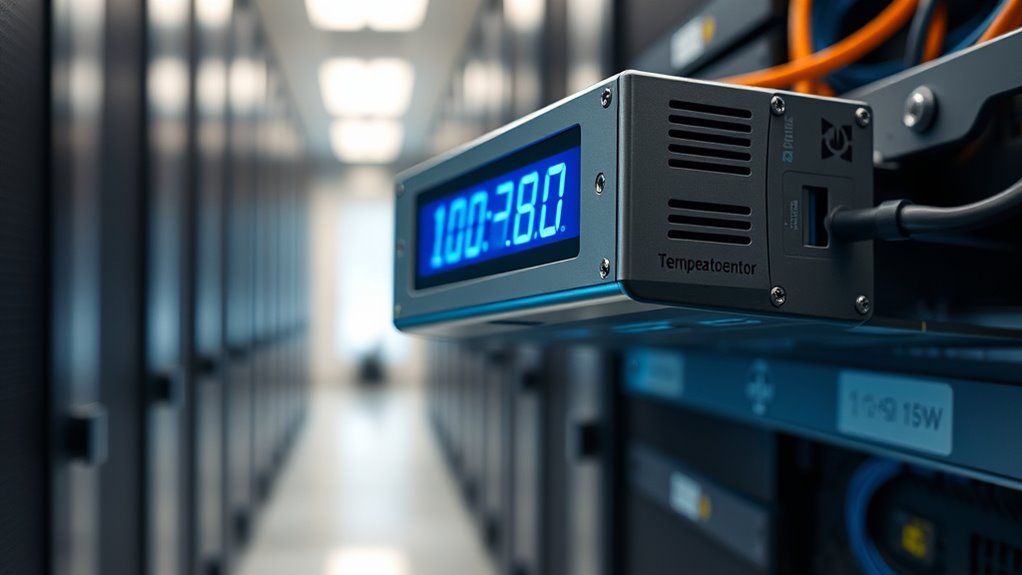
When selecting a temperature and humidity sensor for your rack, I consider several key factors to guarantee ideal performance. These include measurement accuracy standards, compatibility with existing systems, and available connectivity options. Additionally, I look at the environmental range the sensor can handle and its power source needs to make the best choice.
Measurement Accuracy Standards
Choosing the right temperature and humidity sensors for rack environments requires careful attention to measurement accuracy standards, which define how closely a sensor’s readings must match actual conditions. These standards specify the permissible deviation, often expressed as a percentage or fixed value. For temperature sensors, accuracy typically ranges from ±0.2°C to ±1°C, depending on quality and calibration. Humidity sensors usually adhere to ±2% to ±5% RH standards, affecting monitoring reliability. Regulatory standards like ISO 17025 or ASTM may mandate calibration and validation procedures to ensure compliance. Regular calibration against known reference points is essential to maintain precision over the sensor’s lifespan. Paying close attention to these standards helps ensure environmental conditions are accurately monitored, preventing equipment failures or data inaccuracies.
Sensor Compatibility Needs
Selecting the right temperature and humidity sensors for rack environments requires ensuring that their communication protocols and data formats are compatible with your existing monitoring system. I focus on matching the sensor’s communication method—whether Bluetooth, WiFi, cellular, or wired—to what your setup supports. I also check that their connectivity range and frequency provide reliable data transmission within your rack, especially if obstacles are present. It’s essential that the sensor’s data output—digital, analog, or via API—aligns with your data logging and integration systems. Additionally, I verify that the sensor’s measurement range suits your environment’s temperature and humidity levels. Finally, I consider the power supply—battery, AC, or external—to match your installation preferences and maintenance schedule.
Connectivity Options Available
Connectivity options for temperature and humidity sensors in rack environments vary widely, and picking the right one depends on your specific needs. Bluetooth sensors are suitable for small to medium spaces with minimal obstructions, offering a range of up to 330 feet. WiFi-enabled sensors allow remote monitoring over local networks and the internet, providing real-time alerts and data access from afar. Cellular-connected sensors use 4G LTE networks, making them ideal for remote locations with unreliable internet or wide-area coverage needs. Wired sensors, such as rackmount or plug-and-play devices, connect via Ethernet or serial interfaces, ensuring stable, interference-resistant data transmission in critical environments. Your choice hinges on factors like range, stability, and the environment’s connectivity infrastructure.
Environmental Range Suitability
When evaluating sensors for rack environments, it’s important to guarantee their environmental ranges align with your specific conditions. I always check that the temperature measurement range covers your operational temperatures, such as -20°C to 50°C for typical data centers. Humidity ranges should match your needs, like 10% to 90% RH for server rooms or sensitive equipment. It’s vital to consider whether the sensor can handle fluctuations during extreme weather or equipment failures. I also verify that the sensor’s accuracy within its range meets your monitoring requirements, especially in critical environments. Ensuring the sensor’s limits align with the maximum and minimum conditions expected in your rack space helps prevent false readings or missed alerts, maintaining optimal environment control.
Power Source Requirements
The power source you choose for your temperature and humidity sensors plays a crucial role in their placement, reliability, and maintenance needs. Battery-operated sensors offer flexibility, allowing easy placement without power cords, but require regular battery replacements, which can be inconvenient over time. Mains-powered sensors provide continuous, reliable power, ideal for fixed locations near outlets, but their installation may be limited by the availability of power sources. Rechargeable sensors balance sustainability and convenience, needing periodic recharging via USB or similar methods, making them suitable for environments where replacing batteries isn’t practical. When selecting a power source, consider your rack’s environment, accessibility, and maintenance capacity, ensuring the sensor remains operational without frequent intervention or placement restrictions.
Data Logging Capabilities
Selecting a temperature and humidity sensor with durable data logging capabilities is crucial for effective environmental monitoring in racks. These features allow sensors to automatically record readings over time, helping identify trends and maintain ideal conditions. Having the capacity to store large amounts of data ensures thorough tracking without losing critical information, especially during long-term operations. Export options like CSV or Excel make it easy to review data in detail and integrate it into existing management systems. The recording frequency—whether every minute or every 10 seconds—affects the accuracy and granularity of environmental insights. Reliable data logging often includes timestamped entries, secure storage, and options for automatic or manual data retrieval, ensuring consistent and accessible environmental records.
Alarm and Alert Features
To make certain of prompt responses to environmental issues, it’s essential to select sensors that offer customizable alarm and alert features. Look for sensors that let you set high and low thresholds for temperature and humidity, ensuring you get timely notifications when conditions drift outside acceptable ranges. It’s also imperative that the sensor can send alerts through multiple channels—SMS, email, or app notifications—to maximize response speed. Real-time or near-real-time alerts, ideally within seconds to a minute, are pivotal for immediate action. Additionally, check if the sensor can notify multiple contacts simultaneously, enabling coordinated responses. Finally, choose sensors that provide historical data and trend analysis alerts, helping you spot patterns or gradual changes before they become critical issues.
Installation and Maintenance
Selecting a temperature and humidity sensor that fits your rack setup requires careful attention to installation options and ongoing maintenance needs. I recommend choosing sensors compatible with your rack’s dimensions and mounting methods, such as rackmount brackets or DIN rails. Look for models with low maintenance requirements, like self-calibrating features or long-lasting batteries, to minimize upkeep. Guarantee the sensor offers easy access for calibration, cleaning, or replacement without disrupting operations. Additionally, sensors with remote monitoring or alert capabilities simplify maintenance and enable quick responses to environmental changes. Regularly check the sensor’s performance and calibration status, especially in fluctuating environments, to keep readings accurate. Proper installation and routine maintenance are essential for reliable environmental monitoring and ideal rack conditions.
Frequently Asked Questions
How Do Sensors Handle Power Outages or Signal Disruptions?
When there’s a power outage or signal disruption, I rely on sensors with backup power options like batteries or UPS systems. These backups keep the sensors operational, ensuring continuous monitoring. Some sensors store data locally during outages and sync once power is restored. I also choose devices with robust wireless or wired connections that minimize signal issues, so I can trust that my environmental readings remain accurate and up-to-date.
Are There Sensors Suitable for Extreme Temperature or Humidity Ranges?
Yes, there are sensors designed for extreme temperature and humidity ranges. I recommend opting for industrial-grade sensors with built-in protective features like insulation and waterproofing. These sensors can handle harsh environments, from very high to very low temperatures and humidity levels. I’ve used some that operate reliably in extreme conditions, providing accurate readings and helping me maintain ideal rack environments despite challenging conditions.
Can Sensors Be Integrated With Existing Rack Management Systems?
Absolutely, sensors can be integrated with existing rack management systems. I’ve found that many modern sensors offer seamless connectivity through APIs or network protocols like SNMP or Modbus. This allows real-time data sharing and automation. While some setups may need minor configuration, I recommend checking compatibility first. Integration enhances monitoring efficiency, giving you better control without replacing your current infrastructure, making it a smart, cost-effective upgrade.
What Maintenance Is Required for Long-Term Sensor Accuracy?
To keep sensors accurate long-term, I regularly calibrate them according to the manufacturer’s instructions and check for drift or malfunctions. I also clean them periodically to prevent dust buildup and guarantee proper readings. Replacing batteries timely is essential, and I monitor sensor data for inconsistencies. Proper installation and avoiding exposure to extreme conditions help maintain their precision, guaranteeing reliable environmental monitoring over time.
Do Sensors Provide Historical Data Analysis Capabilities?
Did you know that over 80% of modern sensors come with data logging features? Yes, sensors do provide historical data analysis capabilities. I often rely on this feature to track trends and identify potential issues early. With built-in memory or cloud integration, I can review past conditions and make informed decisions. This helps maintain ideal rack environments and prevents costly equipment failures.
Conclusion
Ensuring ideal conditions in your racks is vital, and choosing the right sensor makes all the difference. Did you know that improper temperature and humidity levels can lead to equipment failures, costing businesses up to $100,000 annually? By selecting a reliable sensor, you can prevent costly downtime and protect your investments. I recommend evaluating your needs carefully and opting for a device that offers real-time alerts—it’s a small step toward big savings and peace of mind.


